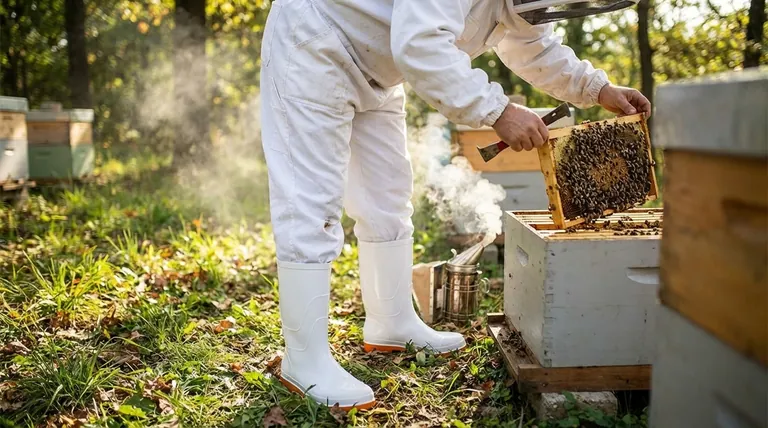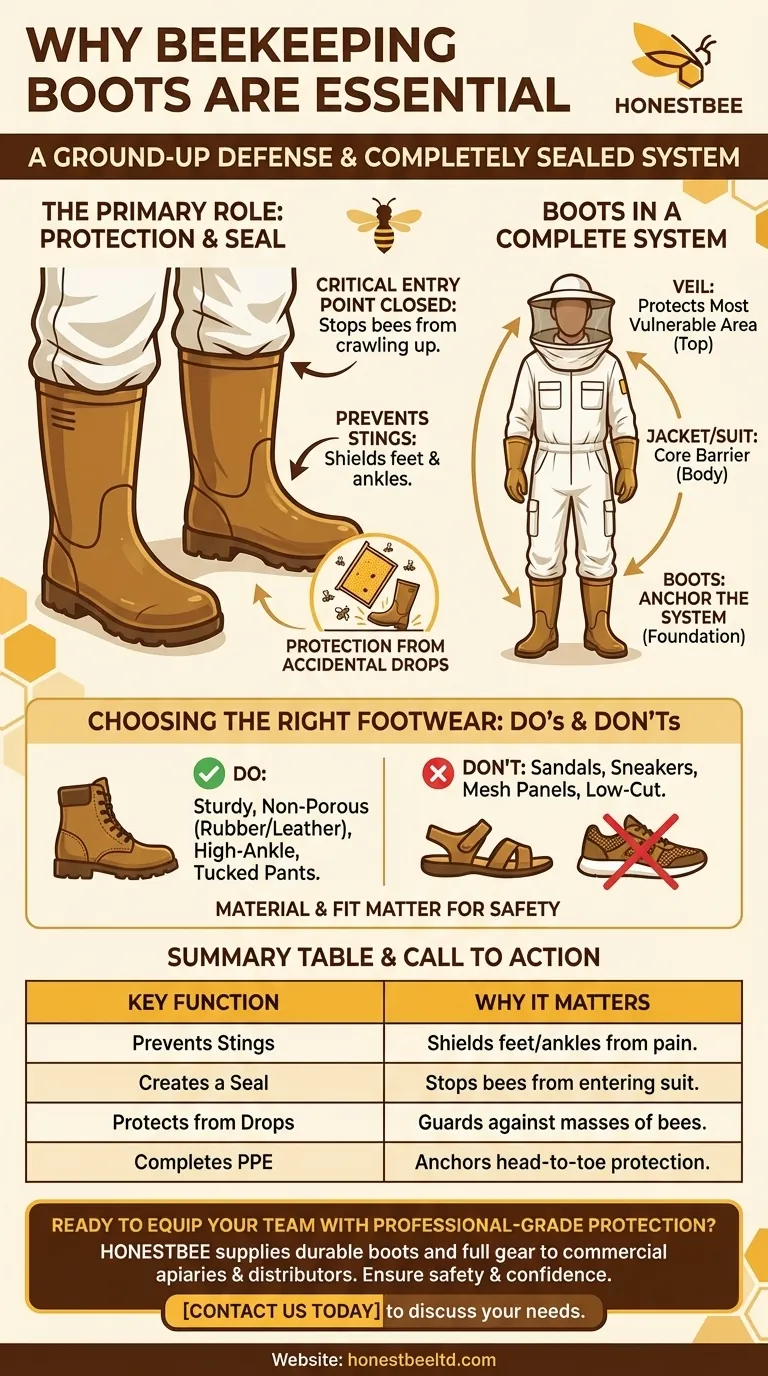At its core, beekeeping boots are essential for protection. They shield your feet and ankles from stings and, just as critically, they seal the bottom of your bee suit. This prevents bees from gaining access inside your clothing, a situation that can quickly turn a routine hive inspection into a dangerous ordeal.
The true purpose of beekeeping boots is not just to protect your feet, but to serve as the foundation of a completely sealed, bee-proof suit. They eliminate a key vulnerability, allowing you to work with confidence and focus entirely on the health of your hive.

The Primary Role of Boots: A Ground-Up Defense
Proper footwear is a non-negotiable component of personal protective equipment (PPE) for any serious beekeeper. It addresses specific and often overlooked risks.
Preventing Stings on Feet and Ankles
While bees typically target areas around the head, the feet and ankles are still vulnerable. A sting in this area is painful and can make it difficult to stand or walk, complicating your work in the apiary.
Closing a Critical Entry Point
The single most important function of boots is to create a seal with your pant legs. Bees that fall to the ground will often crawl upwards seeking entry. Boots that are high enough to tuck your pants into completely eliminate this risk.
Protection from Accidental Drops
A common scenario for stings on the feet occurs when a beekeeper accidentally drops a frame covered in bees. Without the barrier of a sturdy boot, your feet would be immediately exposed to hundreds of defensive insects.
Boots in the Context of a Complete Protective System
Footwear doesn't work in isolation. It is the anchor point for a head-to-toe system designed to let you work safely and calmly.
The Veil: Protecting Your Most Vulnerable Area
The veil is the most critical piece of gear, protecting sensitive areas like your eyes, nose, and mouth. It should always be worn, regardless of what other equipment you use.
Jackets and Suits: The Core Barrier
A beekeeping jacket or a full-body suit provides the main barrier for your torso, arms, and legs. This allows you to handle bees without the constant distraction or threat of stings.
How Boots Complete the System
Your veil protects you from the top, the suit protects your body, and your boots secure the entire system from the ground up. Without proper boots, your expensive bee suit has a significant and easily exploitable weakness.
Understanding the Trade-offs and Best Practices
Simply wearing any closed-toe shoe is not enough. The type of footwear and how you wear it makes a significant difference in your level of safety and comfort.
Why Sandals or Sneakers Fall Short
Sandals offer zero protection and should never be worn in an apiary. Sneakers, even leather ones, are often too low and can have mesh panels that bees can sting through. They do not provide a reliable seal with your pant legs.
Material and Fit Matter
The ideal boot is made from a sturdy, non-porous material like rubber or leather. It should fit snugly and extend high enough to comfortably cover your ankles, allowing your bee suit to be tucked in securely.
The Mental Benefit: Fostering Calm and Focus
Feeling secure in your gear is paramount. When you know you are fully protected from head to toe, you can remain calm and move deliberately. This confidence prevents jerky movements that can agitate bees and makes the entire experience safer and more enjoyable.
Choosing the Right Footwear for Your Needs
Your choice of boots should align with your goals and frequency of hive inspections.
- If your primary focus is maximum protection: Opt for heavy-duty, high-ankle boots made of leather or rubber, ensuring your bee suit legs are securely tucked inside.
- If your primary focus is occasional hive checks and comfort: A sturdy pair of ankle-high work boots can suffice, as long as they are made of a solid material and you can seal the gap with your pants effectively.
- If you are a beginner beekeeper: Do not compromise on safety. Invest in proper boots as part of a full protective suit to build confidence and minimize negative experiences early on.
Proper footwear is the foundation of a safe and confident beekeeping practice.
Summary Table:
| Key Function | Why It Matters |
|---|---|
| Prevents Stings | Shields feet and ankles from painful bee stings. |
| Creates a Seal | Stops bees from crawling up pant legs into your suit. |
| Protects from Drops | Guards against stings if a frame covered in bees is dropped. |
| Completes Your PPE | Anchors the bee suit for a head-to-toe protective system. |
Ready to equip yourself with professional-grade protection? HONESTBEE supplies durable beekeeping boots and full protective gear to commercial apiaries and distributors through our wholesale operations. Ensure your team's safety and confidence during every hive inspection. Contact us today to discuss your equipment needs and request a wholesale catalog!
Visual Guide

Related Products
- Thick PVC Material Waterproof Anti-Slip Wear-Resistant Bee Work Shoes Boots for Garden Outdoor Utility
- Cotton Beekeeping Suit and Round Hat with Veil Bee Keeper Protective Gear
- White Beekeeping Protective Suit and Hat with Fencing Veil for Beekeepers
- Economy Polyester Beekeeping Jacket with Veil and Hat
- Beekeeping Jacket with Hood and Veil for Beekeepers
People Also Ask
- What is the importance of choosing the right beekeeping shoes? Ensure Safety and Comfort in the Apiary
- What is the importance of slip resistance in beekeeping shoes? Prevent Falls and Protect Your Hives
- What is the importance of ensuring no gaps between pants and boots in beekeeping? Prevent Bee Intrusions & Stay Safe
- Why is proper footwear important for beekeepers? Ensure Safety & Stability in the Apiary
- What are some examples of boots used for beekeeping? Essential Protection for Your Apiary Work



















